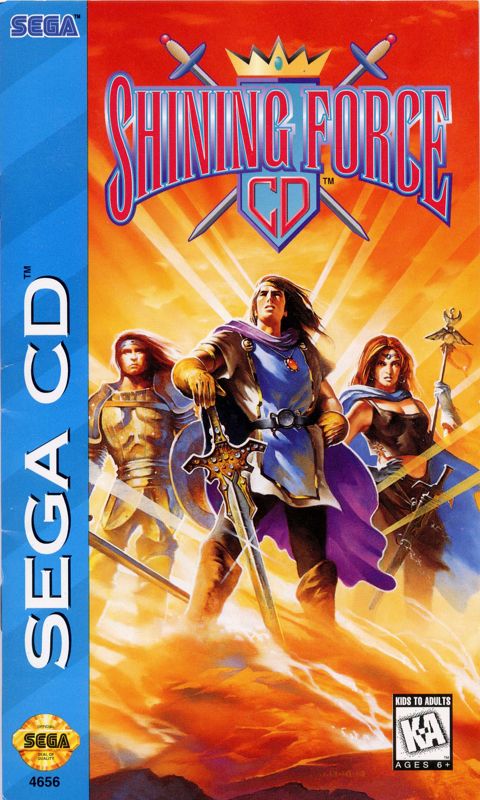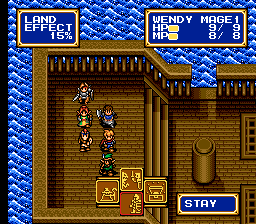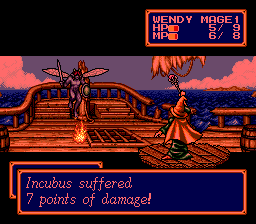Developer: Sonic Co
Publisher: Sega
Release Date: 1995
Now here’s a game that made me want to track down a Sega CD. The two Shining Force games on Sega Genesis were wonderful tactical RPGs that made people like me lifelong fans of the genre. Unfortunately, there did not end up being very many Shining Force games, especially in America. Other than the two Genesis games there is one on Game Gear, a super rare Sega Saturn sequel ,and at least one remake which appeared on Game Boy Advance. Fans of the Force games were also teased over and over again with Shining-titled games that were not tactical. Seriously, there’s like 20 Shining games, and nobody liked any of them as much as the two Genesis Shining Force games. So why aren’t there more Shining Force games? Maybe it’s because Sega of America kept waiting until the last minute to release them. Both Shining Force CD and Shining Force III were among the very last games released for their respective consoles in America, which almost guaranteed that they would not sell. I wanted to play Shining Force III more than anything in 1998, but I wasn’t going to buy a Saturn when the console was pretty much dead. Considering this, Shining Force felt like one of the first franchises whose demise felt like an inside job. Maybe with more love they would still be released Shining Force games, but they were destined to be ultra-rare curiosities. Of course, just about every game on Sega CD is a curiosity, so how does Shining Force CD stack up?
Well, I’m happy to say that for once Sega CD mostly delivered the goods. If you love tactical RPG battles than there’s nothing more robust from the whole 16-bit era as far as I know. It feels like there are more battles in Shining Force CD than the two Genesis titles combined. We’re talking over 60 battles, and somehow they never get tedious. Most of the RPG elements are gone, however. There’s no overworld or towns to visit. It’s just battle, story, preparation, and more battle. This is probably a more common setup for tactical RPGs, but it does lose a little of that made the games stand out. Still, it’s hard to complain too much when the battles are so much fun. It has vintage grid based, single unit tactical combat. I always enjoyed the Shining Force games more than Final Fantasy Tactics because all the units are specific characters. There are no generic units to choose from, and even without as much interaction they feel like unique characters. There are more characters than slots in your party, so it becomes about building them up and picking who works the best. I love this kind of stuff. One oddity is that many of the character names are the same as in Shining Force II despite being used for different characters. I believe the names actually appeared here first, but I’m so attached to Shining Force II that it’s hard for me to accept a different Chester, Sara, and Jaha. So how could the names be in Shining Force CD first when it came out after Shining Force II? The answer to that question is the one thing that keeps Shining Force CD from being a complete slam dunk.
Shining Force CD is actually four different games put together. The first two scenarios are remakes of Game Gear Games. The first one never made it to America, but the second one was released in the states as Shining Force: The Sword of Hajya on Game Gear. The third and fourth scenarios are original to the Sega Cd title, but they are much shorter than the first two. The fourth scenario is even hidden, and you wouldn’t even know how to find if you didn’t know it was there. I didn’t know it existed until it was too late, and I missed the event that triggered it. I already played The Sword of Hajya many years ago, but I don’t really mind playing through the battles again. Of course, it has better graphics and added CD pizzazz, and since the battles are tactical, they are always going to play a little bit differently every time. The downside is that for each scenario the game basically starts over. This means that there is much less character building than in the other games. It’s not very difficult to max out the characters’ levels, and it never gets particularly difficult. I know that at least in the third scenario I could keep leveling up the characters, but they stopped getting stat increases after level 20. That’s a little disappointing for someone who loves character building and level grinding as much as I do.
Still, having four games in one certainly showed off what CD-ROM technology was capable of. There is a lot of game on this disk, plus a compelling story that does mostly tie it all together into one narrative. This is the first Sega CD game I’ve played for this project that couldn’t be done on a console in a good way. It’s not full of FMV gimmicks, and it doesn’t feel like a standard Genesis game with a few cut scenes and better sound. It has some cut scenes and better sound, but it mostly impresses because there’s just so much well-crafted game. I’m sure you’re already tired of hearing me say this four reviews in, but this is the type of game that Sega should’ve concentrated on for the Sega CD. This should not have been quietly released at the end of the console’s life and relegated to obscurity. Oh well, I’m sure they’ll fix their mistakes with the Sega Saturn. That worked out, right?
Shining Force CD is all the way up at #13, which feels somewhat appropriate to me. Not only was this game practically ignored despite being great, but it was also released right at the beginning of Sega’s sudden and depressing decline. In the US it came out almost halfway between the release of the 32X and Saturn, and these back-to-back disappointments would just about doom Sega’s future as a console maker. Of course, Sega would find a successful second life as a publisher for other consoles and survives in this capacity to this day, but Shining Force CD is a tiny glimpse into what could’ve been.
Sega CD Quality Percentage 2/4 or 50%
Sega CD
1. Shining Force CD
2. Lords of Thunder
3. Vay
4. Panic!


